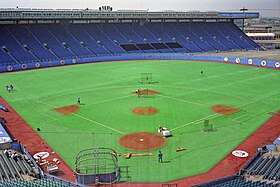
The Canadian Football League is a professional sports league in Canada. The CFL is the highest level of competition in Canadian football. The league consists of nine teams, each located in a city in Canada. They are divided into two divisions: four teams in the East Division and five teams in the West Division. As of 2024, it features a 21-week regular season in which each team plays 18 games with three bye weeks. This season traditionally runs from mid-June to early November. Following the regular season, six teams compete in the league's three-week playoffs, which culminate in the Grey Cup championship game in late November. The Grey Cup is one of Canada's largest annual sports and television events. The CFL was officially named on January 19, 1958, upon the merger between the Interprovincial Rugby Football Union or "Big Four" and the Western Interprovincial Football Union.

Rogers Centre is a multi-purpose retractable roof stadium in Downtown Toronto, Ontario, Canada, situated at the base of the CN Tower near the northern shore of Lake Ontario. Opened in 1989 on the former Railway Lands, it is home to the Toronto Blue Jays of Major League Baseball (MLB). Previously, the stadium was also home to the Toronto Argonauts of the Canadian Football League (CFL) and the Toronto Raptors of the National Basketball Association (NBA). The Buffalo Bills of the National Football League (NFL) played an annual game at the stadium as part of the Bills Toronto Series from 2008 to 2013. While it is primarily a sports venue, it also hosts other large events such as conventions, trade fairs, concerts, travelling carnivals, circuses and monster truck shows.
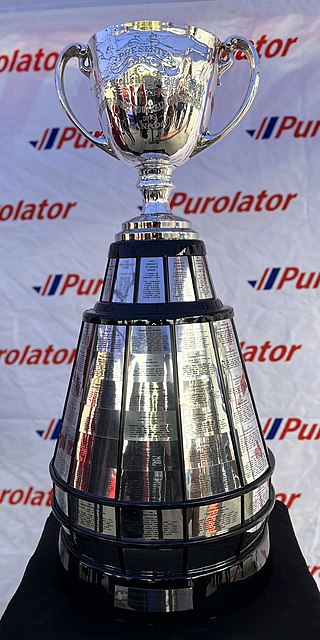
The Grey Cup is both the championship game of the Canadian Football League (CFL) and the trophy awarded to the victorious team playing in the namesake championship of professional Canadian football. The game is contested between the winners of the CFL's East and West Divisional playoffs and is one of Canadian television's largest annual sporting events. The Toronto Argonauts have the most Grey Cup wins (18) since its introduction in 1909, while the Edmonton Elks have the most Grey Cup wins (11) since the merger in 1958. The latest, the 110th Grey Cup, took place in Hamilton, Ontario, on November 19, 2023, when the Montreal Alouettes defeated the Winnipeg Blue Bombers 28–24.
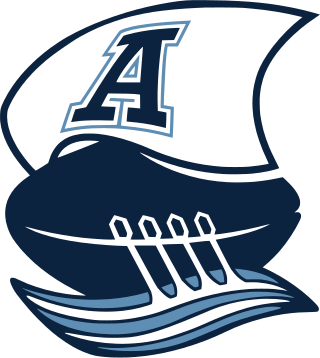
The Toronto Argonauts are a professional Canadian football team competing in the East Division of the Canadian Football League (CFL), based in Toronto, Ontario. Founded in 1873, the team is the oldest existing professional sports team in North America still using its original name, as well as the oldest-surviving team in both the modern-day CFL and East Division. The team's origins date back to a modified version of rugby football that emerged in North America in the latter half of the 19th century. The Argonauts played their home games at Rogers Centre from 1989 until 2016, when the team moved to BMO Field, the fifth stadium site to host the team.

Exhibition Place is a publicly owned mixed-use district in Toronto, Ontario, Canada, located by the shoreline of Lake Ontario, just west of downtown. The 197-acre (80 ha) site includes exhibit, trade, and banquet centres, theatre and music buildings, monuments, parkland, sports facilities, and a number of civic, provincial, and national historic sites. The district's facilities are used year-round for exhibitions, trade shows, public and private functions, and sporting events.

Winnipeg Stadium was a multipurpose stadium in Winnipeg, Manitoba, Canada.

Maple Leaf Sports & Entertainment Ltd. (MLSE) is a professional sports and commercial real estate company based in Toronto, Ontario, Canada. With assets that include franchises in four of the six major professional sports leagues in the United States and Canada, it is the largest sports and entertainment company in Canada, and one of the largest in North America.

BMO Field is an outdoor stadium located at Exhibition Place in Toronto, Ontario, Canada. Constructed on the former Exhibition Stadium site and first opened in 2007, it is the home field of Toronto FC of Major League Soccer (MLS) and the Toronto Argonauts of the Canadian Football League (CFL). BMO Field is owned by the City of Toronto and managed by Maple Leaf Sports & Entertainment, which owns both Toronto FC and the Argonauts. The stadium's naming rights are held by the Bank of Montreal, which is commonly branded as "BMO".
The 1960 CFL season is considered to be the seventh season in modern-day Canadian football, although it is officially the third Canadian Football League season.
The 70th Grey Cup, also known as the "Rain Bowl", was the 1982 Grey Cup Canadian Football League championship game between the Toronto Argonauts and the Edmonton Eskimos. The Eskimos, who were making their sixth consecutive appearance in the CFL championship game, defeated the Argonauts 32–16 on the Eskimos' way to their fifth straight Grey Cup. The game was played on Sunday, November 28, 1982, at Exhibition Stadium in Toronto.
The 64th Grey Cup was played on November 28, 1976, at Exhibition Stadium in Toronto. The Ottawa Rough Riders defeated the Saskatchewan Roughriders 23–20 in what is considered one of the most thrilling Grey Cup games, featuring some of the most exciting plays in Grey Cup history.
The 72nd Grey Cup was the 1984 Canadian Football League championship game, played at Commonwealth Stadium in Edmonton between the Winnipeg Blue Bombers and the Hamilton Tiger-Cats. The Blue Bombers dominated the Tiger-Cats in a 47–17 victory.

The city of Toronto, Ontario, Canada, has a long history of sport. It is home to a number of clubs, including the Granite Club, the Royal Canadian Yacht Club, the Toronto Cricket, Skating and Curling Club, the Argonaut Rowing Club, Toronto Argonauts football club, the Toronto Lawn Tennis Club, and the Badminton and Racquet Club. A number of heritage venues have developed in Toronto such as: Christie Pits, Coca-Cola Coliseum, Varsity Arena, and Maple Leaf Gardens. Toronto is also the location of the Canadian Football League's headquarters.
The National Football League (NFL) has been playing games in Toronto, Ontario, Canada, since 1959 when an interleague game between the Chicago Cardinals of the NFL and the Toronto Argonauts of the Canadian Football League (CFL) took place at Exhibition Stadium. Subsequently, a number of neutral site preseason and regular season games between NFL teams have been staged in the city. Toronto is one of five cities outside the United States, along with London, Mexico City, Frankfurt and Munich, which have hosted regular season NFL games.
Canadian Football League attendance has averaged no fewer than 20,000 spectators per game for every season since 1963. The CFL consistently draws, on average, the third or fourth largest crowds to its games of any professional sports league in North America, ranking behind the National Football League and Major League Baseball, about on par with Liga MX and ahead of Major League Soccer, the National Basketball Association, National Hockey League and the National Lacrosse League.
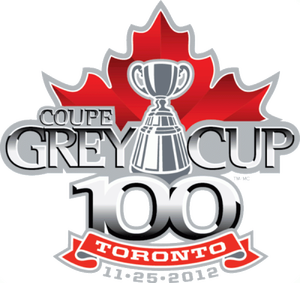
The 100th Grey Cup was a Canadian football game between the East Division champion Toronto Argonauts and the West Division champion Calgary Stampeders of the Canadian Football League to decide the Grey Cup champions of the 2012 season.
The 2015 CFL season was the 62nd season of modern-day Canadian football. Officially, it was the 58th Canadian Football League season. The Edmonton Eskimos won the 103rd Grey Cup on November 29, defeating the Ottawa Redblacks 26–20 in Winnipeg. The schedule was released February 13, 2015 and the regular season began on June 25, 2015.

The 104th Grey Cup was a Canadian football game that was played on November 27, 2016, between the Calgary Stampeders and the Ottawa Redblacks, that decided the champion for the 2016 CFL season. In an upset, the Redblacks defeated the heavily favoured Stampeders 39–33 in overtime to win a championship in just their third season of existence. This was the third Grey Cup game to go into overtime. This also marked a first that a CFL team won its division with a losing record (8–9–1) and became the 3rd worst team to win the Grey Cup.
The 2016 CFL season was the 63rd season of modern-day Canadian football. Officially, it was the 59th Canadian Football League season. Toronto hosted the 104th Grey Cup on November 27. The regular season began on June 23 and ended on November 5.
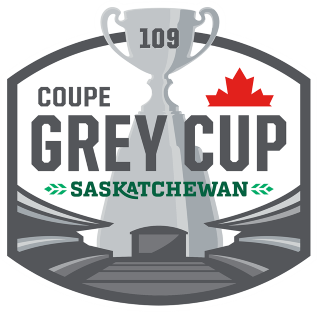
The 109th Grey Cup decided the Canadian Football League (CFL) championship for the 2022 season. The game was played on November 20, at Mosaic Stadium in Regina, Saskatchewan. It marked the fourth Grey Cup game to be held in Regina, and the first to be held at the new Mosaic Stadium as opposed to Taylor Field.
